Affichage une image dans une base de données avec Java Servlet
1. Database
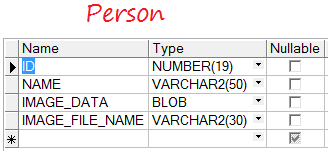
** ORACLE **
create table PERSON
(
ID NUMBER(19) not null,
NAME VARCHAR2(50) not null,
IMAGE_DATA BLOB not null,
IMAGE_FILE_NAME VARCHAR2(30) not null
) ;
alter table PERSON
add constraint PERSON_PK primary key (ID);** SQL SERVER **
create table PERSON
(
ID NUMERIC(19,0) not null,
NAME VARCHAR(50) not null,
IMAGE_DATA IMAGE not null,
IMAGE_FILE_NAME VARCHAR(30) not null
) ;
alter table PERSON
add constraint PERSON_PK primary key (ID);** MYSQL **
create table PERSON
(
ID BIGINT not null,
NAME VARCHAR(50) not null,
IMAGE_DATA LONGBLOB not null,
IMAGE_FILE_NAME VARCHAR(30) not null
) ;
alter table PERSON
add constraint PERSON_PK primary key (ID);
2. Afficher l'image de la base de données avec Servlet
Dans ce document, je vais vous expliquer comment afficher des images sur la base de données en Servlet. Normallement, des données de l'image sont stockées dans la base de données, dans une colonne de données BLOB, vous devez accéder pour récupérer les données sous format byte[] et les enregistre dans response. Dans l'article précédent, je vous ai introduit de la petite base de données, elle va être utilisée dans cette leçon.
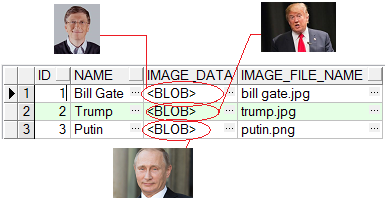
Pour afficher l'image d'uneServlet, et son lien vous pouvez suivre des instructions suivantes:
- http://localhost:8080/ServletExamples/image?id=2
- http://localhost:8080/ServletExamples/image?id=3
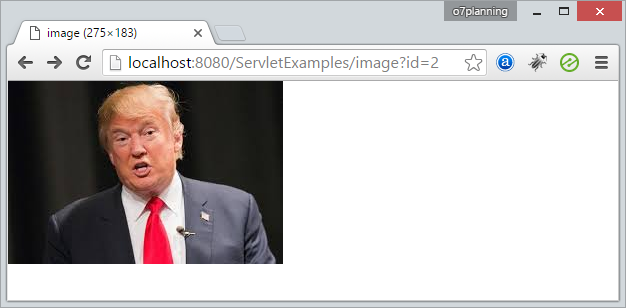
Assurez- vous que vous avez une bonne connaissance de JDBC et Servlet. Si non, vous pouvez faire référence à:JDBC:Servlet:
Project:
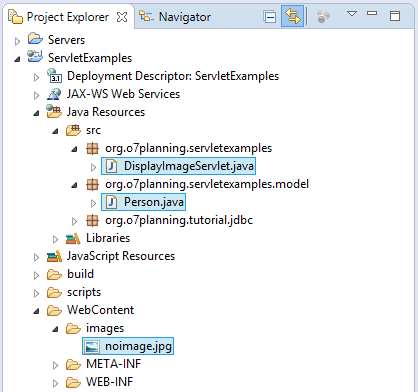
Person.java
package org.o7planning.servletexamples.model;
public class Person {
private Long id;
private String name;
private byte[] imageData;
private String imageFileName;
public Person() {
}
public Person(Long id, String name, String imageFileName, byte[] imageData) {
this.id = id;
this.name = name;
this.imageData = imageData;
this.imageFileName = imageFileName;
}
public Long getId() {
return id;
}
public void setId(Long id) {
this.id = id;
}
public String getName() {
return name;
}
public void setName(String name) {
this.name = name;
}
public byte[] getImageData() {
return imageData;
}
public void setImageData(byte[] imageData) {
this.imageData = imageData;
}
public String getImageFileName() {
return imageFileName;
}
public void setImageFileName(String imageFileName) {
this.imageFileName = imageFileName;
}
}DisplayImageServlet.java
package org.o7planning.servletexamples;
import java.io.IOException;
import java.sql.Connection;
import java.sql.PreparedStatement;
import java.sql.ResultSet;
import java.sql.SQLException;
import javax.servlet.ServletException;
import javax.servlet.annotation.WebServlet;
import javax.servlet.http.HttpServlet;
import javax.servlet.http.HttpServletRequest;
import javax.servlet.http.HttpServletResponse;
import org.o7planning.servletexamples.model.Person;
import org.o7planning.tutorial.jdbc.ConnectionUtils;
// /image?id=123
@WebServlet(urlPatterns = { "/image" })
public class DisplayImageServlet extends HttpServlet {
private static final long serialVersionUID = 1L;
public DisplayImageServlet() {
super();
}
private Person getImageInTable(Connection conn, Long id) throws SQLException {
String sql = "Select p.Id,p.Name,p.Image_Data,p.Image_File_Name "//
+ " from Person p where p.id = ?";
PreparedStatement pstm = conn.prepareStatement(sql);
pstm.setLong(1, id);
ResultSet rs = pstm.executeQuery();
if (rs.next()) {
String name = rs.getString("Name");
byte[] imageData = rs.getBytes("Image_Data");
String imageFileName = rs.getString("Image_File_Name");
return new Person(id, name, imageFileName, imageData);
}
return null;
}
@Override
protected void doGet(HttpServletRequest request, HttpServletResponse response)
throws ServletException, IOException {
Connection conn = null;
try {
// Get Database Connection.
// (See more in JDBC Tutorial)
conn = ConnectionUtils.getMyConnection();
Long id = null;
try {
id = Long.parseLong(request.getParameter("id"));
} catch (Exception e) {
}
Person person = getImageInTable(conn, id);
if (person == null) {
// No record found, redirect to default image.
response.sendRedirect(request.getContextPath() + "/images/noimage.jpg");
return;
}
// trump.jpg, putin.png
String imageFileName = person.getImageFileName();
System.out.println("File Name: "+ imageFileName);
// image/jpg
// image/png
String contentType = this.getServletContext().getMimeType(imageFileName);
System.out.println("Content Type: "+ contentType);
response.setHeader("Content-Type", contentType);
response.setHeader("Content-Length", String.valueOf(person.getImageData().length));
response.setHeader("Content-Disposition", "inline; filename=\"" + person.getImageFileName() + "\"");
// Write image data to Response.
response.getOutputStream().write(person.getImageData());
} catch (Exception e) {
throw new ServletException(e);
}
}
@Override
protected void doPost(HttpServletRequest request, HttpServletResponse response)
throws ServletException, IOException {
doGet(request, response);
}
}Exécutez des applications:
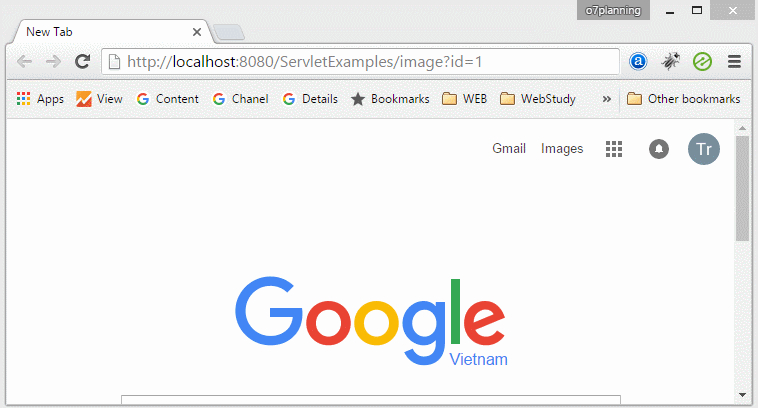
Tutoriels de programmation Java Servlet/JSP
- Installer Tomcat Server pour Eclipse
- Installer Glassfish Web Server sur Windows
- Exécutez l'application Web Java Maven dans Tomcat Maven Plugin
- Exécutez l'application Web Java Maven dans Jetty Maven Plugin
- Exécuter une tâche d'arrière-plan dans l'application Java Servlet
- Le Tutoriel de Java Servlet pour des débutants
- Le Tutoriel de Java Servlet Filter
- Le Tutoriel de Java JSP
- Le Tutoriel de Java JSP Standard Tag Library (JSTL)
- Installer Web Tools Platform pour Eclipse
- Créez une application de connexion simple et sécurisez les pages avec Java Servlet Filter
- Créer une application Web Java simple à l'aide de Servlet, JSP et JDBC
- Upload et Download de fichiers stockés sur le disque dur avec Java Servlet
- Télécharger et télécharger des fichiers à partir de la base de données à l'aide de Java Servlet
- Affichage une image dans une base de données avec Java Servlet
- Redirection 301, redirection permanente dans Java Servlet
- Comment redirige http en https automatiquement dans une application web de Java?
- Utiliser Google reCAPTCHA dans l'application Web Java
Show More